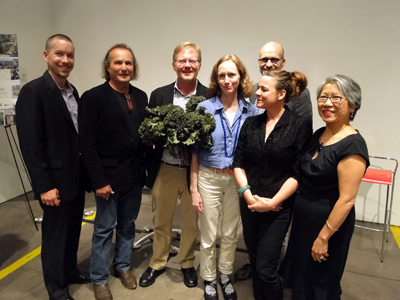by: Julie Engh Assoc. AIA
Event: Farming our Future: Diversity and Design Ingenuity in NYC Urban Agriculture
Location: Center for Architecture, 08.01.12
Moderator: Susan Chin, FAIA, Executive Director, Design Trust for Public Space
Speakers: Colin Cathcart, AIA, Partner, Kiss + Cathcart Architects; Pat Kirshner, Director of Operations & Planning, The Battery Conservancy; Elliott Maltby, Principal, thread collective; Toby Tiktinsky, Director, Bright Farms; Lee Weintraub, FASLA, Principal, Lee Weintraub Landscape Architecture; Michael Wadman, Vice President, Phipps Houses;
Organizers: AIANY, Design Trust for Public Space, and the New York Chapter of the American Society of Landscape Architects
Celebrating the Design Trust for Public Space and Added Value’s Five Borough Farm project, the night kicked off with Rick Bell, FAIA, AIANY executive director, asserting that the Center for Architecture’s newly-green garden – a product of the collaboration of the ASLA’s young landscape architects committee and ENYA – proves amazing things can happen in small spaces. Moderator Susan Chin, FAIA, Design Trust executive director, explained the Five Borough Farm website, publication, and posters that demonstrate the value of urban agriculture and provide a roadmap for expanding the movement.
Colin Cathcart, AIA, of Kiss + Cathcart Architects, endorsed scaling up urban agriculture. Hydroponic and other urban agriculture methodologies, Cathcart believes, have the potential to render unnecessary large-scale, fossil fuel-based agriculture, and its subsequent global warming emissions. Organizations such as Bright Farms, explained Director Toby Titinsky, aim to make this large-scale commercial urban farming a reality. By farming on grocery store rooftops and partnering in long-term retail distribution agreements, Bright Farms hopes to facilitate consumers purchasing produce mere hours after it is picked.
By introducing urban agriculture throughout public housing, Elliot Maltby of thread collective asserted these “towers in the park” could be transformed into “towers in the farm.” Presenting the realities of developing and maintaining a large scale urban farm, The Battery Conservancy’s Pat Kirshner explained the two year old Battery Urban Farm, which includes bamboo fencing repurposed from the Metropolitan Museum of Art’s “Big Bambu” installation and a design based on Battery Park’s infamous wild turkey Zelda, has already welcomed more than 870 students to its soil.
Landscape architect Lee Weintraub, FASLA, and real estate developer Michael Wadman praised the South Bronx housing development Via Verde, designed by Grimshaw Architects and Dattner Architects, for successfully integrating urban agriculture into large-scale urban housing. Via Verde‘s fully accessible garden plots spiral from various courtyards and outdoor spaces at grade level up to rooftops. While political, philosophical, and design elements motivated Via Verde’s farming components, Wadman noted that the real estate industry, specifically at certain Long Island City luxury housing developments, is considering urban farming’s potential as a marketable tenant amenity.
The speakers overwhelmingly affirmed urban agriculture’s diverse benefits – not only the positive health effects resulting from better access to fresh produce, but its potential social, economic, and ecological benefits as well. While existing programs such as GrowNYC and those offered by the Lower East Side Ecology Center are already thriving, for the urban agriculture movement to capitalize on burgeoning public interest and the rapidly increasing consumer demand for locally grown produce, there must be increased municipal government support and an investment in soil, land, seeds, and other critical resources.
Julie Engh, Assoc. AIA, LEED AP, is an intern architect active in the Emerging New York Architects (ENYA) and Architectural Tourism Committees.








